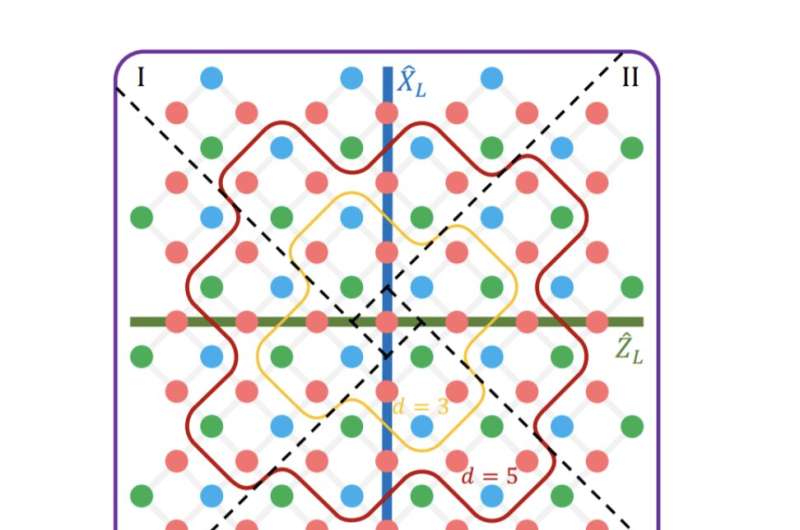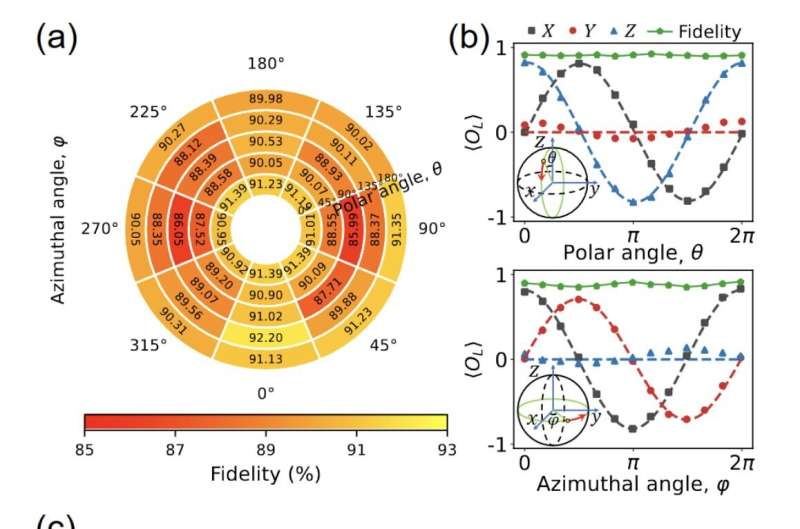December 27, 2023 feature
This article has been reviewed according to Science X's editorial process and policies. Editors have highlighted the following attributes while ensuring the content's credibility:
fact-checked
peer-reviewed publication
trusted source
proofread
A logical magic state with fidelity beyond distillation threshold realized on superconducting quantum processor

Quantum computers have the potential to outperform conventional computers on some tasks, including complex optimization problems. However, quantum computers are also vulnerable to noise, which can lead to computational errors.
Engineers have been trying to devise fault-tolerant quantum computing approaches that could be more resistant to noise and could thus be scaled up more robustly. One common approach to attain fault-tolerance is the preparation of magic states, which introduce so-called non-Clifford gates.
Researchers at University of Science and Technology of China, the Henan Key Laboratory of Quantum Information and Cryptography and the Hefei National Laboratory recently demonstrated the preparation of a logical magic state with fidelity beyond the distillation threshold on a superconducting quantum processor. Their paper, published in Physical Review Letters, outlines a viable and effective strategy to generate high-fidelity logical magic states, an approach to realize fault-tolerant quantum computing.
"We have a long-term plan in the field of quantum error correction," Prof. Xiao-Bo Zhu, co-author of the paper, told Phys.org. "Following the completion of our previous work on a distance-3 surface code for repeated error correction, we consider the next focus to be on the preparation of logical magic states."
The ultimate objective of the recent research by Prof. Zhu and their colleagues is to realize robust, fault-tolerant, universal quantum computing. The preparation of logical magic states is a key step to implement non-Clifford logical gates, which in turn lead to the attainment of fault-tolerant quantum computing.
"In simple terms, the basic idea of our protocol is to first inject the state to be prepared into one of the qubits in the surface code, and then 'propagate' the state information to the entire surface code, thereby achieving a logical state preparation," Prof. Zhu explained. "In this protocol, the choice of the inject position of the state to be prepared and the initialization states of other qubits is important."

The protocol proposed by this team of researchers outlines a simple, experimentally viable and scalable strategy to prepare high-fidelity raw magic states in superconducting quantum processors. As part of their recent study, Prof. Zhu and his colleagues applied this protocol on Zuchongzhi 2.1, a 66-qubit quantum professor with a tunable coupling design.
"This processor's design allows us to manipulate the interaction between any two adjacent qubits, ensuring that our quantum gates be sufficiently high fidelity despite a high degree of parallelism," Prof. Zhu said. "This design is also conducive to expanding the scale of qubits on one processor."
When the researchers implemented their protocol on the Zuchongzhi 2.1 processor, they achieved very promising results. Specifically, they non-destructively prepared three logical magic states with logical fidelities of 0.8771±0.0009, 0.9090±0.0009, and 0.8890±0.0010, respectively, which are higher than the state distillation protocol threshold, 0.859 (for H-type magic state) and 0.827 (for T-type magic state).
"We have achieved a critical milestone in the development of fault-tolerant computing based on the surface code by successfully preparing a distance-three logical magic state with fidelity surpassing the distillation threshold," Prof. Zhu said. "This outcome implies that we can feed low-fidelity magic states into the magic state distillation circuit, undergo multiple distillations to obtain sufficiently high-fidelity magic states, and subsequently employ them to construct fault-tolerant non-Clifford logical gates."
In the future, the protocol developed by Prof. Zhu and his colleagues could be used by other research teams to realize high-fidelity raw logical magic states, utilizing a broader range of superconducting quantum processors. Ultimately, it could contribute to the realization of robust fault-tolerance quantum computing, which could in turn enable the development of larger-scale quantum computers.
"In the field of quantum error correction, we plan to continue exploring two main research directions," Prof. Zhu added. "First, we aim to enhance the performance of a logical qubit (or error-corrected quantum memory) by reducing the physical manipulation error rate and increasing the number of encoded qubits, thereby suppressing the logical error rate to practical levels. Second, we conduct experimental research on error-corrected logical operations, such as lattice surgery, for application in future fault-tolerant quantum computing."
More information: Yangsen Ye et al, Logical Magic State Preparation with Fidelity beyond the Distillation Threshold on a Superconducting Quantum Processor, Physical Review Letters (2023). DOI: 10.1103/PhysRevLett.131.210603
Journal information: Physical Review Letters
© 2023 Science X Network





















